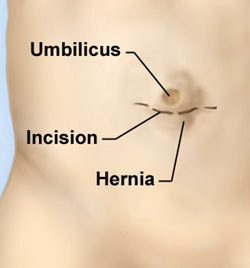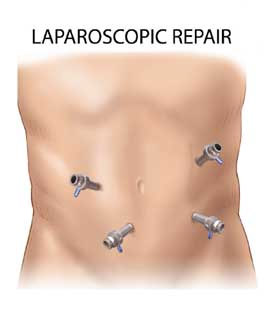Repair of Umbilical (bellybutton) Hernia
What are the treatments for umbilical hernia?
Different methods are used for managing umbilical hernia, with the open and laparoscopic options being the most commonly chosen.
When hernia are symptomatic surgery is considered the best modality of treatment. Common treatments performed for the management of umbilical hernia include:
- Open Hernia surgery
- Laparoscopic umbilical surgery
- Robotic ventral hernia surgery
- The use of an abdominal wall binder is occasionally prescribed for patients who cannot undergo surgery but are often ineffective.
WHAT HAPPENS IF UMBILCIAL HERNIA ARE NOT TREATED?
- A hernia does not get better over time, nor will it go away by itself.
- Overtime they tend to enlarge, stretch the skin and become more prominent and painful
- The contents of the hernia may become trapped or lose their blood supply requiring an emergency operation or even bowel removal.
WHAT ARE THE ADVANTAGES OF LAPAROSCOPIC UMBILICAL HERNIA REPAIR?
Results may vary depending on the type of procedure and each patient’s overall condition. Common advantages may include:
- No scars around the umbilicus
- Best for larger or recurrent hernia
- Quicker return to normal activity
- Less wound infections
- Smaller incisions
WHAT ARE THE ADVANTAGES OF OPEN UMBILICAL HERNIA REPAIR?
Common advantages may include:
- Less complex procedure
- Best for smaller hernia
- Mesh free for small hernia defects
- Less risk of bowel injury
- Less incisions
AM I A CANDIDATE FOR UMBILICAL HERNIA SURGERY?
At your consultation Dr Gandy will assess whether a umbilical hernia surgery is right for you. The procedure may not be best for some patients who have had extensive previous abdominal surgery, or in people underlying medical conditions. Very small hernia can sometimes be performed in an open fashion without the need for a hernia mesh, which may be preferable.
WHAT PREPARATIONS ARE REQUIRED FOR UMBILICAL HERNIA SURGERY?
- Most simple hernia operations are performed on an outpatient basis, and therefore you will probably go home on the same or following day that the operation is performed.
- More complex or recurrent hernia operations may require you to spend multiple days in the hospital after surgery.
- After discussing the options and potential risks you will need to provide written consent for surgery.
- You will also be asked to clean your bellybutton with liquid soap 3 days prior to surgery in order to reduce the risk of infection.
- Do not shave or exfoliate your abdomen wall as this can lead to increased chance of infection, when shaving is required it is done immediately prior to surgery while under anaesthetic.
- It is recommended that you shower the night before or morning of the operation.
- It is highly recommended and sometimes required that you quit smoking prior to surgery
- You should continue to exercise up to the time of surgery unless exercise is causing severe pain.
- You should also eat healthily and if possible, lose weight to reduce the strain on your abdomen after the surgery.
HOW IS UMBILICAL HERNIA SURGERY PERFORMED?
There are two options available for a patient with a ventral hernia, but surgery is the preferred treatment for hernia with symptoms.
Surgery is the preferred treatment and is done in one of two ways:
- The traditional open approachis done through an incision in the abdominal wall underneath the umbilicus. The defect in the abdominal wall is closed with strong sutures after mesh is placed under the repaired tissue to stop the hernia coming back. Small hernias can be repaired without the need for a hernia mesh.

- The Laparoscopic approachis a laparoscopic umbilical hernia repair. A 12mm incision is made on the flank and a plastic trocar placed to allow a laparoscopic camera to be inserted into the abdomen. Low pressure carbon dioxide gas is used to inflate the abdomen. 2-4 small (5mm) incisions will be required for other small cannulas for placement of specialised laparoscopic instruments to remove any scar tissue and to insert a surgical mesh into the abdomen. After any scar tissue is divided the defect in the abdominal wall is repaired with sutures from inside and then a specially designed coated mesh is placed under the repair. The mesh is secured in placed with sutures, glue or special dissolving surgical tacks Usually, three or four 5mm inch incisions are necessary. This operation is performed under general anaesthesia.

WHAT SHOULD I EXPECT THE DAY OF VENTRAL HERNIA REPAIR SURGERY?
- You usually arrive at the hospital the morning of the operation.
- A qualified medical staff member will typically place a small needle or catheter into your vein to dispense medication during the surgery. Often pre-operative medications, such as antibiotics, may be given.
- You will have a full general anaesthetic.
- Following the operation, you will be taken to the recovery room and remain there until you are fully awake.
- Many patients go home the same day of surgery, while others may need admission for a day or more post-operatively. The need to stay in the hospital will be discussed with you prior to surgery.
https://www.keyholesurgeon.com.au/pre-operative-instructions-sydney-randwick.html
WHAT SHOULD I EXPECT AFTER UMBILICAL HERNIA SURGERY?
- Patients are encouraged to engage in light activity while at home after surgery. Your surgeon will determine the extent of activity, including lifting and other forms of physical exertion. Follow your surgeon’s advice carefully.
- Post-operative discomfort is usually mild to moderate. Pain killers will be prescribed to you to take home
- If you begin to have fever, chills, vomiting, are unable to urinate, or experience drainage from your incisions you should call your Dr Gandy’s office immediately.
- Most patients are able to get back to their normal activities in a short period of time. These activities include showering, driving, walking upstairs, work and sexual intercourse.
- https://www.keyholesurgeon.com.au/inguinal-hernia-recovery-chart-sydney-randwick.html
- Occasionally, patients develop a lump or some swelling in the area where their hernia had been. Frequently this is due to fluid collecting within the previous space of the hernia. Most often this will disappear on its own with time. If not, your surgeon may aspirate this with a needle in the office.
- You should ask your physician when you need to schedule a follow-up appointment. Typically, patients schedule follow-up appointments within 3-4 weeks after their operation.
WHAT COMPLICATIONS CAN OCCUR?
- The risks of surgery will be discussed with you at your consultation. In general surgery is recommended when the risk of surgery are low or lower than the risk of not performing surgery.
- Specific risks may include during the operation may include, bleeding or bruising, pain, injury to the abdominal organs or bowel, infection and rarely complications due to the mesh used.
- The long-term recurrence rate is similar for laparoscopic and open approachs. The risk of the hernia coming back is based on a number of factors and your specific risk will be discussed at your consultation.
